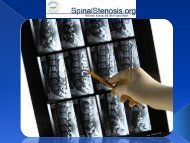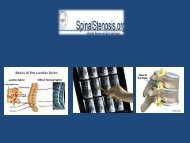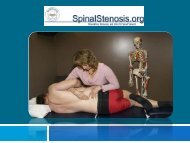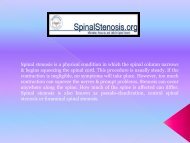spinal stenosis treatment plans
Epidural injections are useful for people who’re suffering from severe, painful symptoms. However, the relief from epidurals only lasts for 2 or 3 weeks, and the long-term efficiency of epidurals beyond that is arguable.
Epidural injections are useful for people who’re suffering from severe, painful symptoms. However, the relief from epidurals only lasts for 2 or 3 weeks, and the long-term efficiency of epidurals beyond that is arguable.
Create successful ePaper yourself
Turn your PDF publications into a flip-book with our unique Google optimized e-Paper software.
Spinal <strong>stenosis</strong> is a consequence of the space between the spine being crowed<br />
out from excessive tissue or bone growth. The consequence is nerve swelling<br />
& damage guiding to excruciating symptoms such as stiffness, tingling, pain<br />
and inflammation.<br />
Spinal <strong>stenosis</strong> can happen at any point of your spine, but is most common in<br />
the lower back & neck area. Nearly 75 percent of the cases affect the lower<br />
back region. Have you or a loved one recently been diagnosed? If so, read on<br />
to learn important myths and facts about treating <strong>spinal</strong> <strong>stenosis</strong>.
Surgery is the only form of cure:<br />
Though <strong>spinal</strong> <strong>stenosis</strong> surgery has proven to be a productive<br />
method, but there’re also many non-invasive <strong>treatment</strong> procedures that<br />
your doctor may recommend you to engage in before surgery. Some of<br />
the non-invasive Spinal <strong>stenosis</strong> <strong>treatment</strong> options include:<br />
· Chiropractic Treatment<br />
· Physical therapy<br />
· Epidural Injections<br />
· Prescription medication<br />
· Weight loss & proper diet<br />
· Spinal Decompression Therapy
Exercise is discouraged:<br />
This is a partial truth. The incorrect types of workout or too much<br />
activity can actually make your <strong>spinal</strong> <strong>stenosis</strong> symptoms to<br />
deteriorate. Long periods of standing or physical exertion seem to<br />
prompt flare ups for many people. In addition, short bursts of intense<br />
activity can lead to pain and injury.<br />
The best type of activity is low-intensity, low-impact exercise such as<br />
swimming, elliptical training, yoga and biking. It is also very important<br />
to stretch before and after exercise.
It affects only elder people:<br />
Spinal <strong>stenosis</strong> does affect older people, but those aged 30 to 50<br />
or people who’ve injured their back are also at risk. Spinal<br />
<strong>stenosis</strong> usually targets active, healthy inviduals who’re otherwise<br />
in great health.
Only anti-inflammatory medications have been found to help with<br />
<strong>spinal</strong> <strong>stenosis</strong> <strong>treatment</strong>:<br />
Anti-inflammatory medications play a large role in the supervision of<br />
<strong>spinal</strong> <strong>stenosis</strong> symptoms, but that's not the only type of medication<br />
that's often prescribed to patients. Some people with <strong>spinal</strong> <strong>stenosis</strong> have<br />
found relief through anti-depressants, which have been found to reduce<br />
pain. Muscle relaxers are also useful in <strong>spinal</strong> <strong>stenosis</strong> <strong>treatment</strong> <strong>plans</strong>.
Thank you…<br />
Contact us<br />
1818 N Vermont Ave<br />
Los Angeles, CA, United States<br />
PH-:(551) 774 4330<br />
http://<strong>stenosis</strong><strong>spinal</strong>.org/







